Reflective Essay on Communication and Patient Care in Nursing
VerifiedAdded on 2022/09/26
|6
|1497
|21
Essay
AI Summary
This reflective essay examines the crucial role of communication in nursing practice, focusing on a case study involving a patient with a hearing impairment. The essay, framed within Driscoll's reflective cycle, explores the challenges of ineffective communication between healthcare professionals and the patient, highlighting the impact on patient care and health outcomes. It emphasizes the need for patient-centered care, advocating for the use of both verbal and non-verbal communication strategies to improve understanding and empower patients. The essay also underscores the importance of empathy, sensitivity to patient needs, and the involvement of interprofessional teams to enhance the quality of healthcare services, particularly for elderly patients. The author reflects on the experience, emphasizing the importance of communication advocacy and the need for nurses to make informed decisions to ensure patient satisfaction and improved health outcomes. The essay concludes by highlighting the critical role of effective communication in fostering patient engagement and promoting better healthcare delivery.
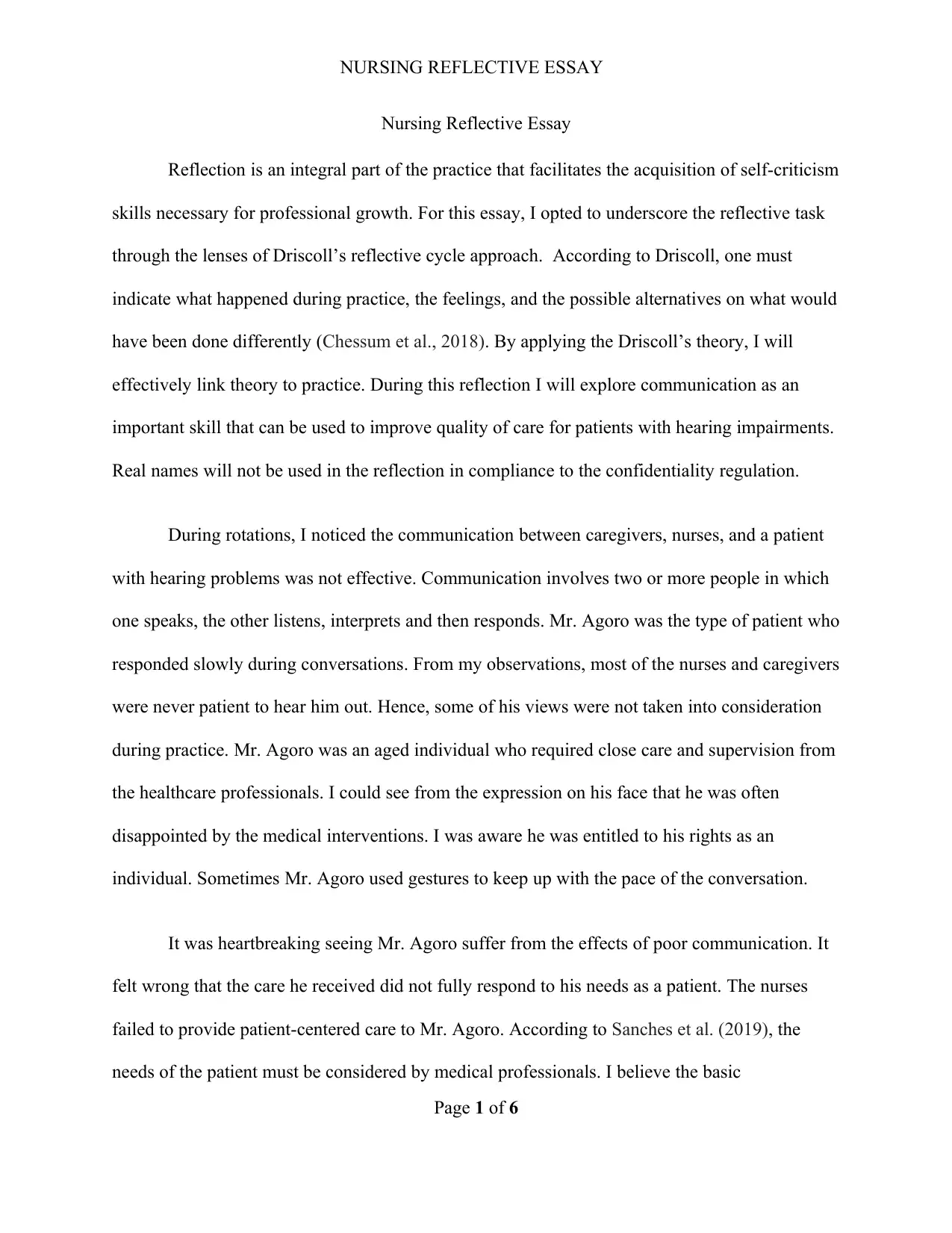
NURSING REFLECTIVE ESSAY
Nursing Reflective Essay
Reflection is an integral part of the practice that facilitates the acquisition of self-criticism
skills necessary for professional growth. For this essay, I opted to underscore the reflective task
through the lenses of Driscoll’s reflective cycle approach. According to Driscoll, one must
indicate what happened during practice, the feelings, and the possible alternatives on what would
have been done differently (Chessum et al., 2018). By applying the Driscoll’s theory, I will
effectively link theory to practice. During this reflection I will explore communication as an
important skill that can be used to improve quality of care for patients with hearing impairments.
Real names will not be used in the reflection in compliance to the confidentiality regulation.
During rotations, I noticed the communication between caregivers, nurses, and a patient
with hearing problems was not effective. Communication involves two or more people in which
one speaks, the other listens, interprets and then responds. Mr. Agoro was the type of patient who
responded slowly during conversations. From my observations, most of the nurses and caregivers
were never patient to hear him out. Hence, some of his views were not taken into consideration
during practice. Mr. Agoro was an aged individual who required close care and supervision from
the healthcare professionals. I could see from the expression on his face that he was often
disappointed by the medical interventions. I was aware he was entitled to his rights as an
individual. Sometimes Mr. Agoro used gestures to keep up with the pace of the conversation.
It was heartbreaking seeing Mr. Agoro suffer from the effects of poor communication. It
felt wrong that the care he received did not fully respond to his needs as a patient. The nurses
failed to provide patient-centered care to Mr. Agoro. According to Sanches et al. (2019), the
needs of the patient must be considered by medical professionals. I believe the basic
Page 1 of 6
Nursing Reflective Essay
Reflection is an integral part of the practice that facilitates the acquisition of self-criticism
skills necessary for professional growth. For this essay, I opted to underscore the reflective task
through the lenses of Driscoll’s reflective cycle approach. According to Driscoll, one must
indicate what happened during practice, the feelings, and the possible alternatives on what would
have been done differently (Chessum et al., 2018). By applying the Driscoll’s theory, I will
effectively link theory to practice. During this reflection I will explore communication as an
important skill that can be used to improve quality of care for patients with hearing impairments.
Real names will not be used in the reflection in compliance to the confidentiality regulation.
During rotations, I noticed the communication between caregivers, nurses, and a patient
with hearing problems was not effective. Communication involves two or more people in which
one speaks, the other listens, interprets and then responds. Mr. Agoro was the type of patient who
responded slowly during conversations. From my observations, most of the nurses and caregivers
were never patient to hear him out. Hence, some of his views were not taken into consideration
during practice. Mr. Agoro was an aged individual who required close care and supervision from
the healthcare professionals. I could see from the expression on his face that he was often
disappointed by the medical interventions. I was aware he was entitled to his rights as an
individual. Sometimes Mr. Agoro used gestures to keep up with the pace of the conversation.
It was heartbreaking seeing Mr. Agoro suffer from the effects of poor communication. It
felt wrong that the care he received did not fully respond to his needs as a patient. The nurses
failed to provide patient-centered care to Mr. Agoro. According to Sanches et al. (2019), the
needs of the patient must be considered by medical professionals. I believe the basic
Page 1 of 6
Paraphrase This Document
Need a fresh take? Get an instant paraphrase of this document with our AI Paraphraser
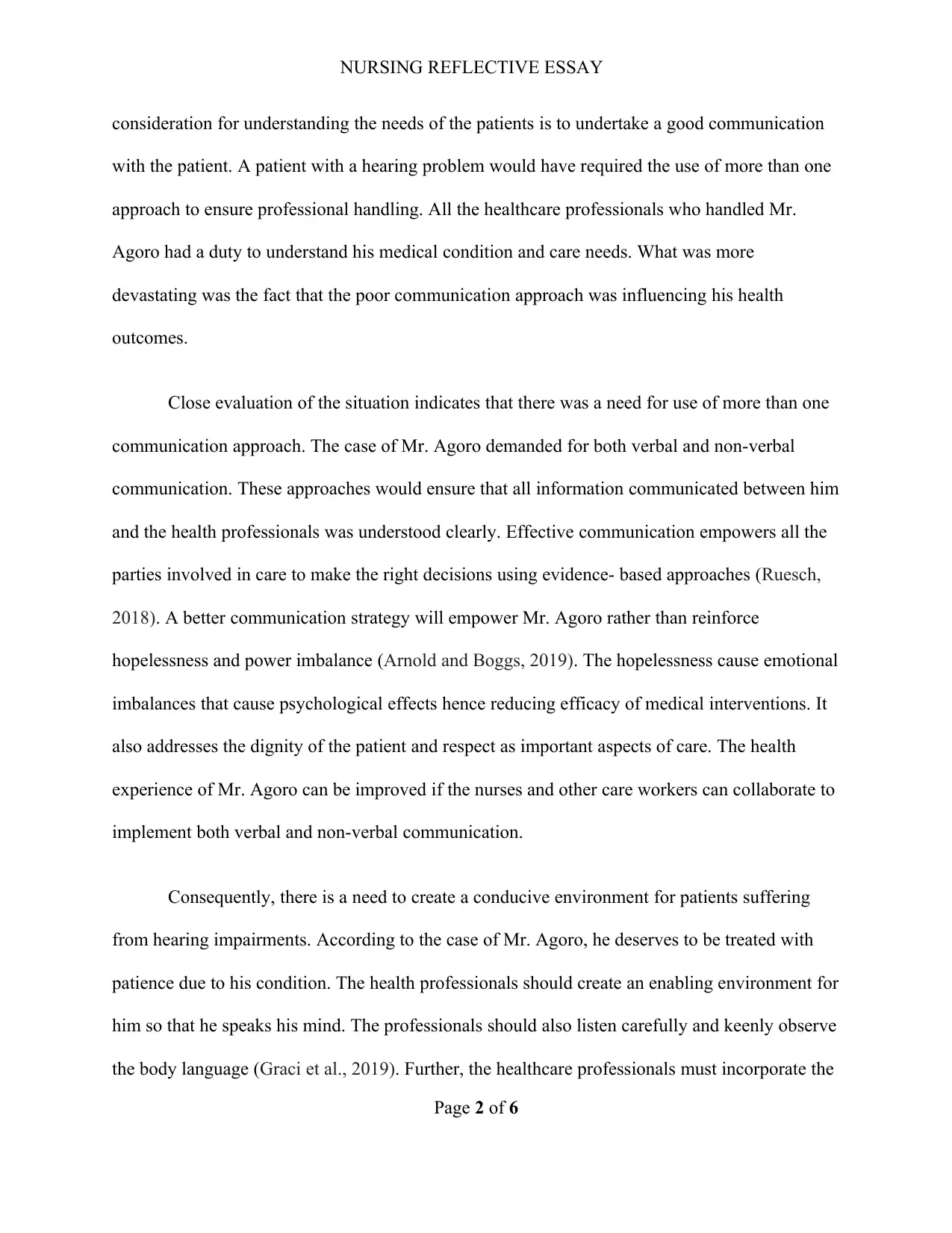
NURSING REFLECTIVE ESSAY
consideration for understanding the needs of the patients is to undertake a good communication
with the patient. A patient with a hearing problem would have required the use of more than one
approach to ensure professional handling. All the healthcare professionals who handled Mr.
Agoro had a duty to understand his medical condition and care needs. What was more
devastating was the fact that the poor communication approach was influencing his health
outcomes.
Close evaluation of the situation indicates that there was a need for use of more than one
communication approach. The case of Mr. Agoro demanded for both verbal and non-verbal
communication. These approaches would ensure that all information communicated between him
and the health professionals was understood clearly. Effective communication empowers all the
parties involved in care to make the right decisions using evidence- based approaches (Ruesch,
2018). A better communication strategy will empower Mr. Agoro rather than reinforce
hopelessness and power imbalance (Arnold and Boggs, 2019). The hopelessness cause emotional
imbalances that cause psychological effects hence reducing efficacy of medical interventions. It
also addresses the dignity of the patient and respect as important aspects of care. The health
experience of Mr. Agoro can be improved if the nurses and other care workers can collaborate to
implement both verbal and non-verbal communication.
Consequently, there is a need to create a conducive environment for patients suffering
from hearing impairments. According to the case of Mr. Agoro, he deserves to be treated with
patience due to his condition. The health professionals should create an enabling environment for
him so that he speaks his mind. The professionals should also listen carefully and keenly observe
the body language (Graci et al., 2019). Further, the healthcare professionals must incorporate the
Page 2 of 6
consideration for understanding the needs of the patients is to undertake a good communication
with the patient. A patient with a hearing problem would have required the use of more than one
approach to ensure professional handling. All the healthcare professionals who handled Mr.
Agoro had a duty to understand his medical condition and care needs. What was more
devastating was the fact that the poor communication approach was influencing his health
outcomes.
Close evaluation of the situation indicates that there was a need for use of more than one
communication approach. The case of Mr. Agoro demanded for both verbal and non-verbal
communication. These approaches would ensure that all information communicated between him
and the health professionals was understood clearly. Effective communication empowers all the
parties involved in care to make the right decisions using evidence- based approaches (Ruesch,
2018). A better communication strategy will empower Mr. Agoro rather than reinforce
hopelessness and power imbalance (Arnold and Boggs, 2019). The hopelessness cause emotional
imbalances that cause psychological effects hence reducing efficacy of medical interventions. It
also addresses the dignity of the patient and respect as important aspects of care. The health
experience of Mr. Agoro can be improved if the nurses and other care workers can collaborate to
implement both verbal and non-verbal communication.
Consequently, there is a need to create a conducive environment for patients suffering
from hearing impairments. According to the case of Mr. Agoro, he deserves to be treated with
patience due to his condition. The health professionals should create an enabling environment for
him so that he speaks his mind. The professionals should also listen carefully and keenly observe
the body language (Graci et al., 2019). Further, the healthcare professionals must incorporate the
Page 2 of 6
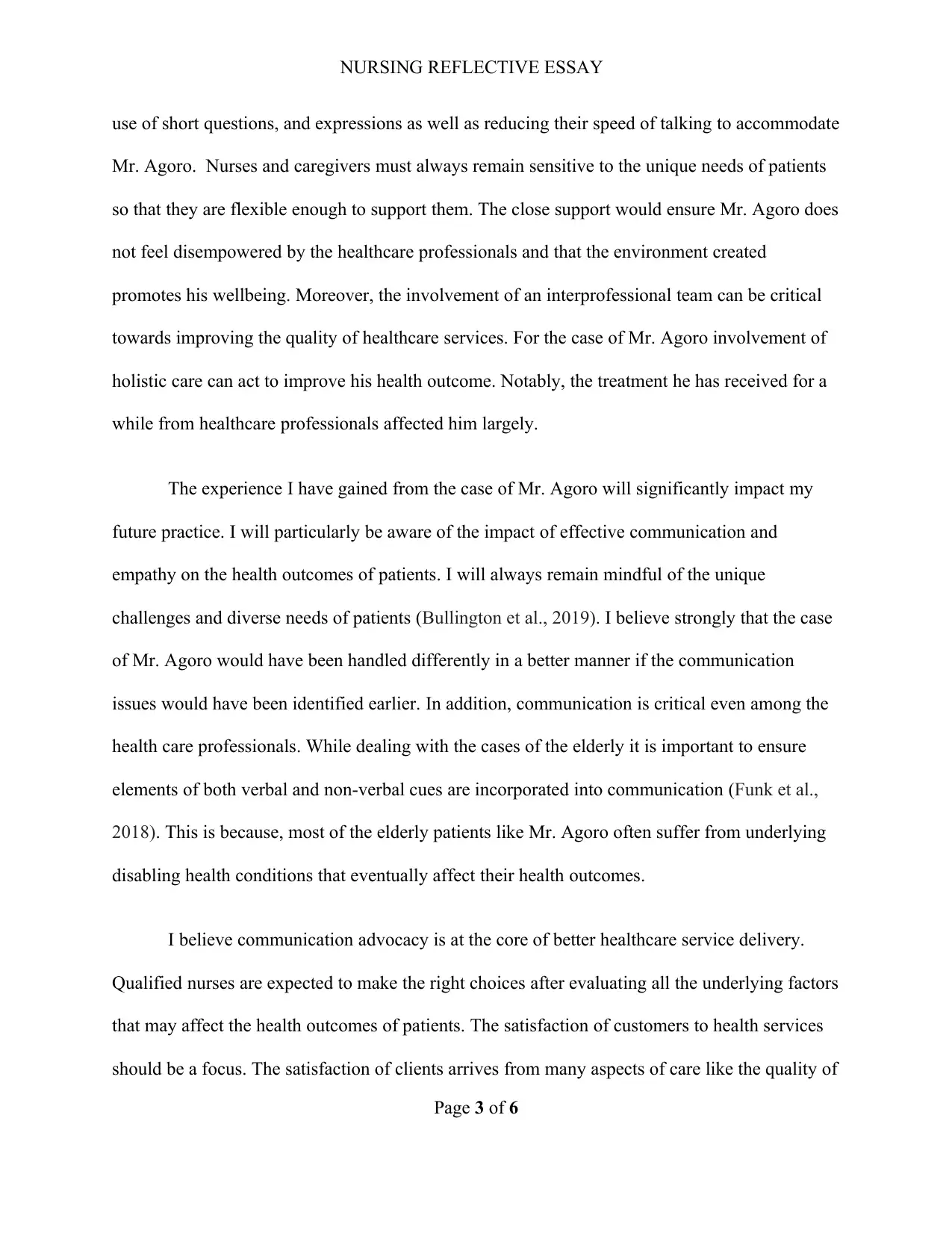
NURSING REFLECTIVE ESSAY
use of short questions, and expressions as well as reducing their speed of talking to accommodate
Mr. Agoro. Nurses and caregivers must always remain sensitive to the unique needs of patients
so that they are flexible enough to support them. The close support would ensure Mr. Agoro does
not feel disempowered by the healthcare professionals and that the environment created
promotes his wellbeing. Moreover, the involvement of an interprofessional team can be critical
towards improving the quality of healthcare services. For the case of Mr. Agoro involvement of
holistic care can act to improve his health outcome. Notably, the treatment he has received for a
while from healthcare professionals affected him largely.
The experience I have gained from the case of Mr. Agoro will significantly impact my
future practice. I will particularly be aware of the impact of effective communication and
empathy on the health outcomes of patients. I will always remain mindful of the unique
challenges and diverse needs of patients (Bullington et al., 2019). I believe strongly that the case
of Mr. Agoro would have been handled differently in a better manner if the communication
issues would have been identified earlier. In addition, communication is critical even among the
health care professionals. While dealing with the cases of the elderly it is important to ensure
elements of both verbal and non-verbal cues are incorporated into communication (Funk et al.,
2018). This is because, most of the elderly patients like Mr. Agoro often suffer from underlying
disabling health conditions that eventually affect their health outcomes.
I believe communication advocacy is at the core of better healthcare service delivery.
Qualified nurses are expected to make the right choices after evaluating all the underlying factors
that may affect the health outcomes of patients. The satisfaction of customers to health services
should be a focus. The satisfaction of clients arrives from many aspects of care like the quality of
Page 3 of 6
use of short questions, and expressions as well as reducing their speed of talking to accommodate
Mr. Agoro. Nurses and caregivers must always remain sensitive to the unique needs of patients
so that they are flexible enough to support them. The close support would ensure Mr. Agoro does
not feel disempowered by the healthcare professionals and that the environment created
promotes his wellbeing. Moreover, the involvement of an interprofessional team can be critical
towards improving the quality of healthcare services. For the case of Mr. Agoro involvement of
holistic care can act to improve his health outcome. Notably, the treatment he has received for a
while from healthcare professionals affected him largely.
The experience I have gained from the case of Mr. Agoro will significantly impact my
future practice. I will particularly be aware of the impact of effective communication and
empathy on the health outcomes of patients. I will always remain mindful of the unique
challenges and diverse needs of patients (Bullington et al., 2019). I believe strongly that the case
of Mr. Agoro would have been handled differently in a better manner if the communication
issues would have been identified earlier. In addition, communication is critical even among the
health care professionals. While dealing with the cases of the elderly it is important to ensure
elements of both verbal and non-verbal cues are incorporated into communication (Funk et al.,
2018). This is because, most of the elderly patients like Mr. Agoro often suffer from underlying
disabling health conditions that eventually affect their health outcomes.
I believe communication advocacy is at the core of better healthcare service delivery.
Qualified nurses are expected to make the right choices after evaluating all the underlying factors
that may affect the health outcomes of patients. The satisfaction of customers to health services
should be a focus. The satisfaction of clients arrives from many aspects of care like the quality of
Page 3 of 6
⊘ This is a preview!⊘
Do you want full access?
Subscribe today to unlock all pages.

Trusted by 1+ million students worldwide
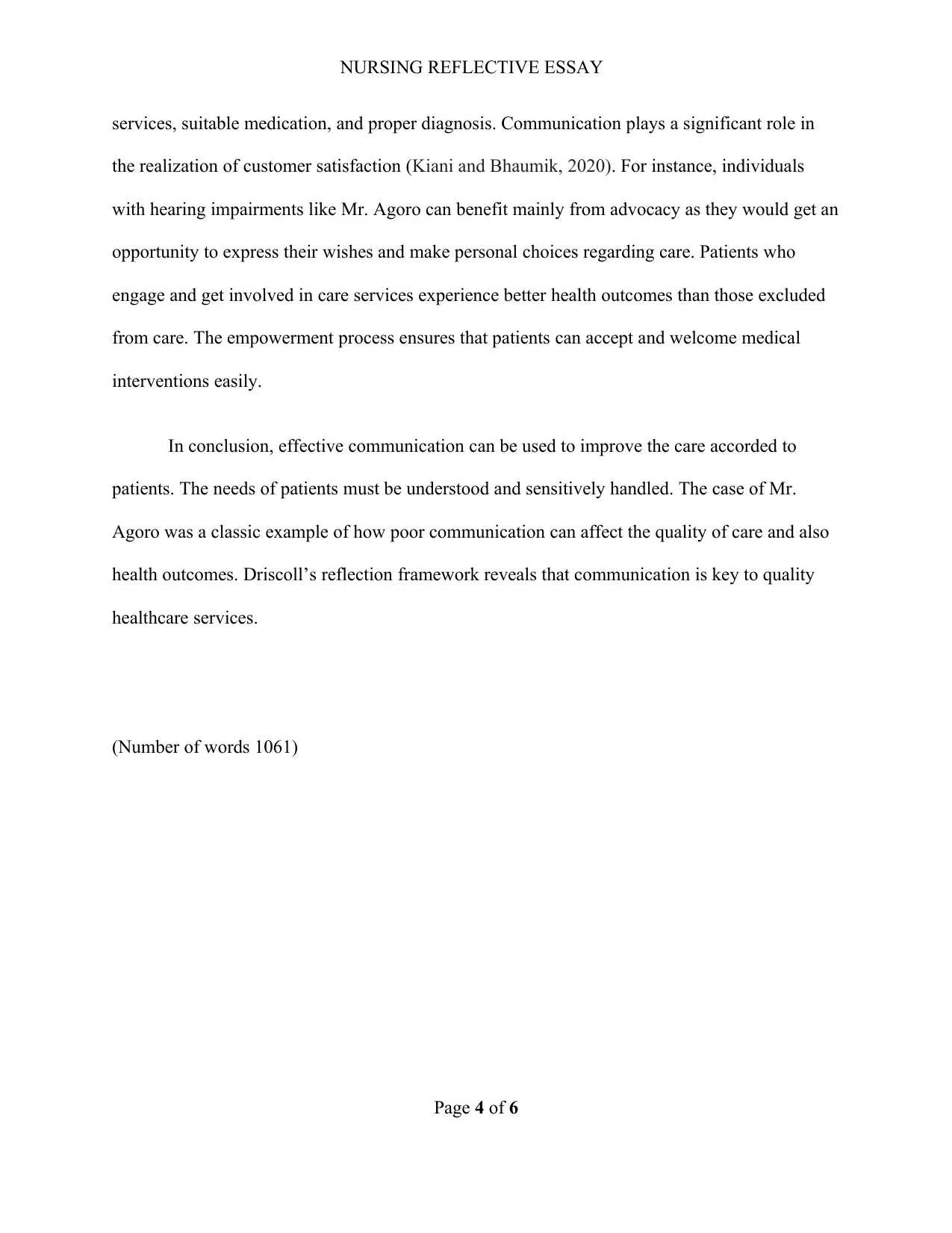
NURSING REFLECTIVE ESSAY
services, suitable medication, and proper diagnosis. Communication plays a significant role in
the realization of customer satisfaction (Kiani and Bhaumik, 2020). For instance, individuals
with hearing impairments like Mr. Agoro can benefit mainly from advocacy as they would get an
opportunity to express their wishes and make personal choices regarding care. Patients who
engage and get involved in care services experience better health outcomes than those excluded
from care. The empowerment process ensures that patients can accept and welcome medical
interventions easily.
In conclusion, effective communication can be used to improve the care accorded to
patients. The needs of patients must be understood and sensitively handled. The case of Mr.
Agoro was a classic example of how poor communication can affect the quality of care and also
health outcomes. Driscoll’s reflection framework reveals that communication is key to quality
healthcare services.
(Number of words 1061)
Page 4 of 6
services, suitable medication, and proper diagnosis. Communication plays a significant role in
the realization of customer satisfaction (Kiani and Bhaumik, 2020). For instance, individuals
with hearing impairments like Mr. Agoro can benefit mainly from advocacy as they would get an
opportunity to express their wishes and make personal choices regarding care. Patients who
engage and get involved in care services experience better health outcomes than those excluded
from care. The empowerment process ensures that patients can accept and welcome medical
interventions easily.
In conclusion, effective communication can be used to improve the care accorded to
patients. The needs of patients must be understood and sensitively handled. The case of Mr.
Agoro was a classic example of how poor communication can affect the quality of care and also
health outcomes. Driscoll’s reflection framework reveals that communication is key to quality
healthcare services.
(Number of words 1061)
Page 4 of 6
Paraphrase This Document
Need a fresh take? Get an instant paraphrase of this document with our AI Paraphraser
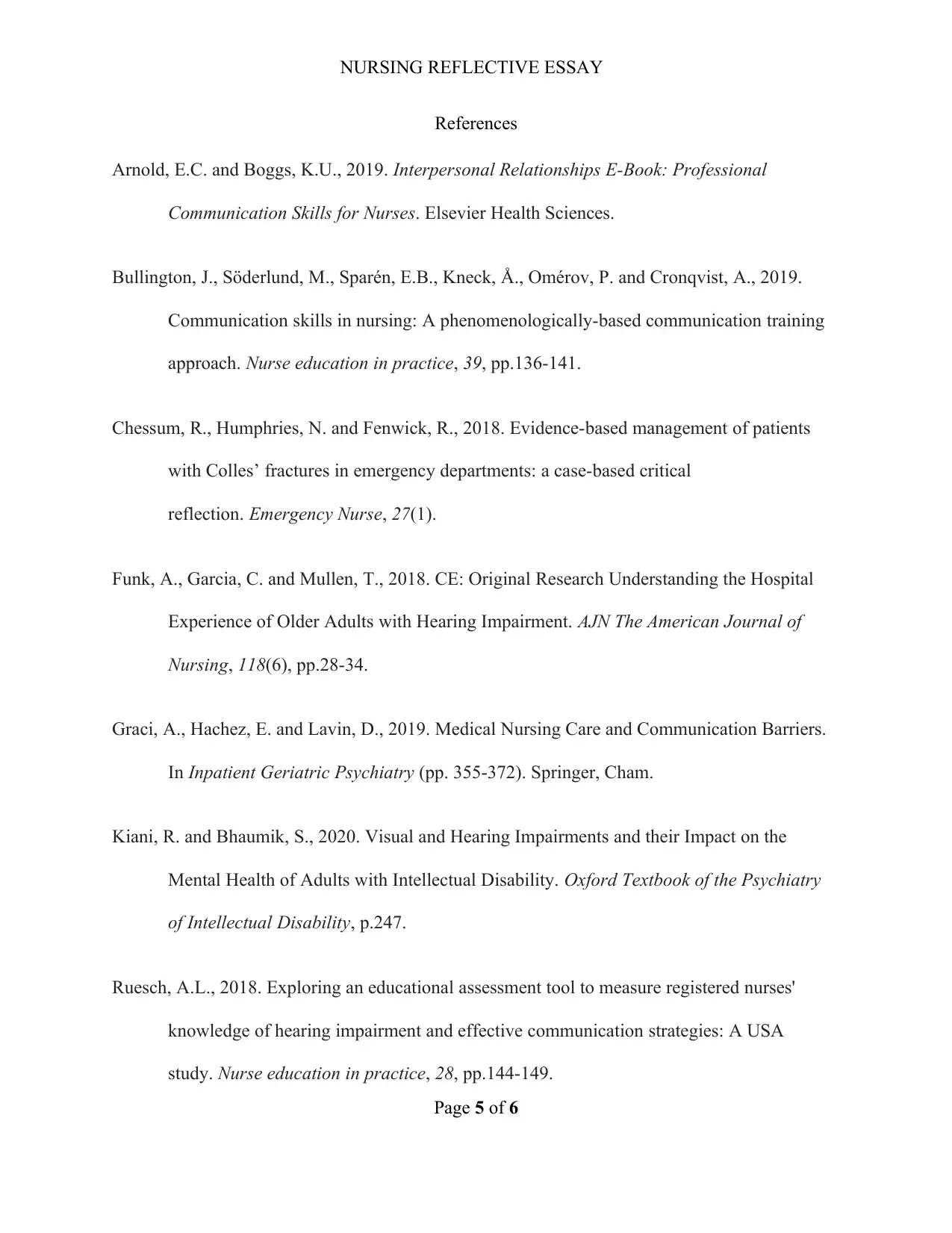
NURSING REFLECTIVE ESSAY
References
Arnold, E.C. and Boggs, K.U., 2019. Interpersonal Relationships E-Book: Professional
Communication Skills for Nurses. Elsevier Health Sciences.
Bullington, J., Söderlund, M., Sparén, E.B., Kneck, Å., Omérov, P. and Cronqvist, A., 2019.
Communication skills in nursing: A phenomenologically-based communication training
approach. Nurse education in practice, 39, pp.136-141.
Chessum, R., Humphries, N. and Fenwick, R., 2018. Evidence-based management of patients
with Colles’ fractures in emergency departments: a case-based critical
reflection. Emergency Nurse, 27(1).
Funk, A., Garcia, C. and Mullen, T., 2018. CE: Original Research Understanding the Hospital
Experience of Older Adults with Hearing Impairment. AJN The American Journal of
Nursing, 118(6), pp.28-34.
Graci, A., Hachez, E. and Lavin, D., 2019. Medical Nursing Care and Communication Barriers.
In Inpatient Geriatric Psychiatry (pp. 355-372). Springer, Cham.
Kiani, R. and Bhaumik, S., 2020. Visual and Hearing Impairments and their Impact on the
Mental Health of Adults with Intellectual Disability. Oxford Textbook of the Psychiatry
of Intellectual Disability, p.247.
Ruesch, A.L., 2018. Exploring an educational assessment tool to measure registered nurses'
knowledge of hearing impairment and effective communication strategies: A USA
study. Nurse education in practice, 28, pp.144-149.
Page 5 of 6
References
Arnold, E.C. and Boggs, K.U., 2019. Interpersonal Relationships E-Book: Professional
Communication Skills for Nurses. Elsevier Health Sciences.
Bullington, J., Söderlund, M., Sparén, E.B., Kneck, Å., Omérov, P. and Cronqvist, A., 2019.
Communication skills in nursing: A phenomenologically-based communication training
approach. Nurse education in practice, 39, pp.136-141.
Chessum, R., Humphries, N. and Fenwick, R., 2018. Evidence-based management of patients
with Colles’ fractures in emergency departments: a case-based critical
reflection. Emergency Nurse, 27(1).
Funk, A., Garcia, C. and Mullen, T., 2018. CE: Original Research Understanding the Hospital
Experience of Older Adults with Hearing Impairment. AJN The American Journal of
Nursing, 118(6), pp.28-34.
Graci, A., Hachez, E. and Lavin, D., 2019. Medical Nursing Care and Communication Barriers.
In Inpatient Geriatric Psychiatry (pp. 355-372). Springer, Cham.
Kiani, R. and Bhaumik, S., 2020. Visual and Hearing Impairments and their Impact on the
Mental Health of Adults with Intellectual Disability. Oxford Textbook of the Psychiatry
of Intellectual Disability, p.247.
Ruesch, A.L., 2018. Exploring an educational assessment tool to measure registered nurses'
knowledge of hearing impairment and effective communication strategies: A USA
study. Nurse education in practice, 28, pp.144-149.
Page 5 of 6
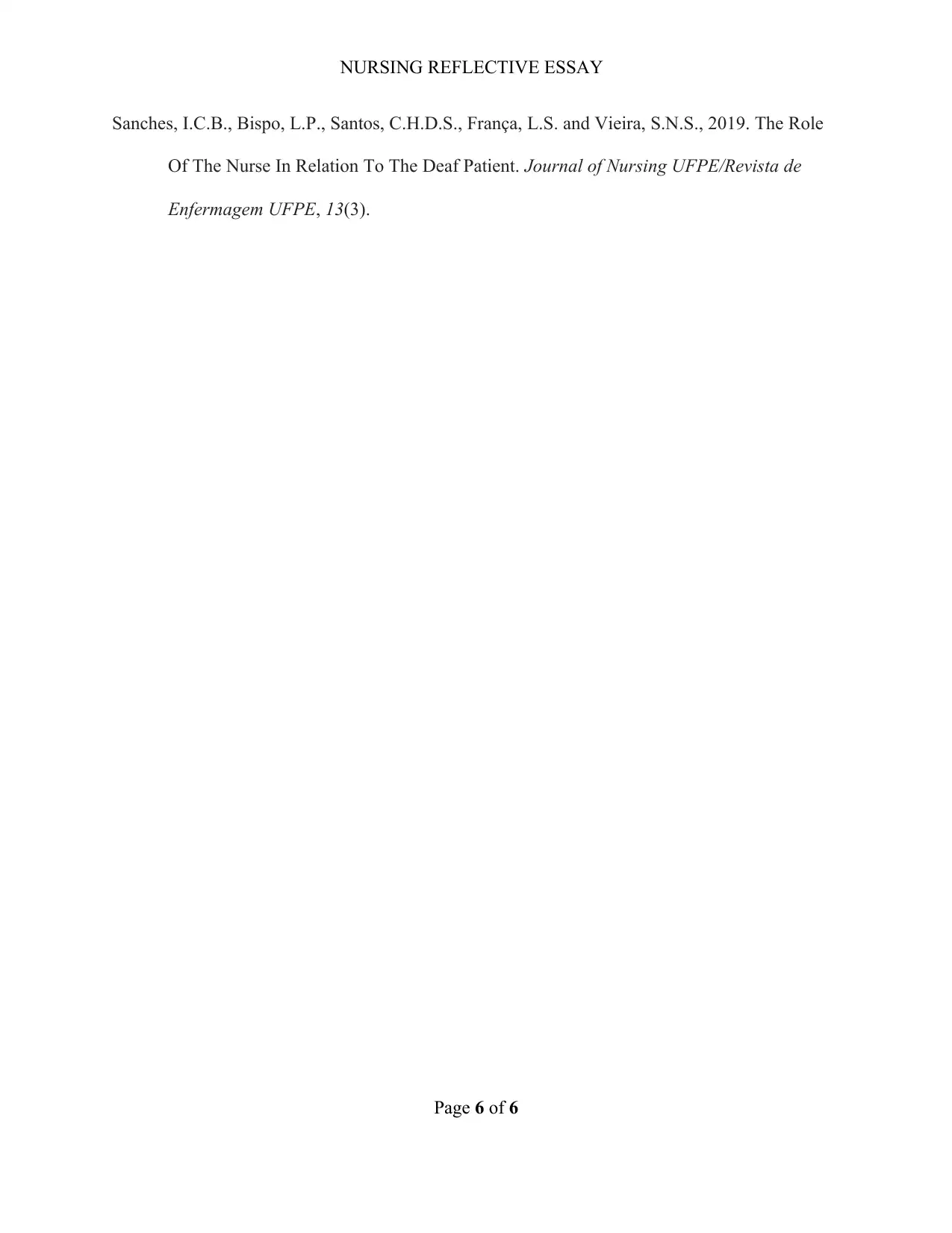
NURSING REFLECTIVE ESSAY
Sanches, I.C.B., Bispo, L.P., Santos, C.H.D.S., França, L.S. and Vieira, S.N.S., 2019. The Role
Of The Nurse In Relation To The Deaf Patient. Journal of Nursing UFPE/Revista de
Enfermagem UFPE, 13(3).
Page 6 of 6
Sanches, I.C.B., Bispo, L.P., Santos, C.H.D.S., França, L.S. and Vieira, S.N.S., 2019. The Role
Of The Nurse In Relation To The Deaf Patient. Journal of Nursing UFPE/Revista de
Enfermagem UFPE, 13(3).
Page 6 of 6
⊘ This is a preview!⊘
Do you want full access?
Subscribe today to unlock all pages.

Trusted by 1+ million students worldwide
1 out of 6
Related Documents
Your All-in-One AI-Powered Toolkit for Academic Success.
+13062052269
info@desklib.com
Available 24*7 on WhatsApp / Email
![[object Object]](/_next/static/media/star-bottom.7253800d.svg)
Unlock your academic potential
Copyright © 2020–2025 A2Z Services. All Rights Reserved. Developed and managed by ZUCOL.





